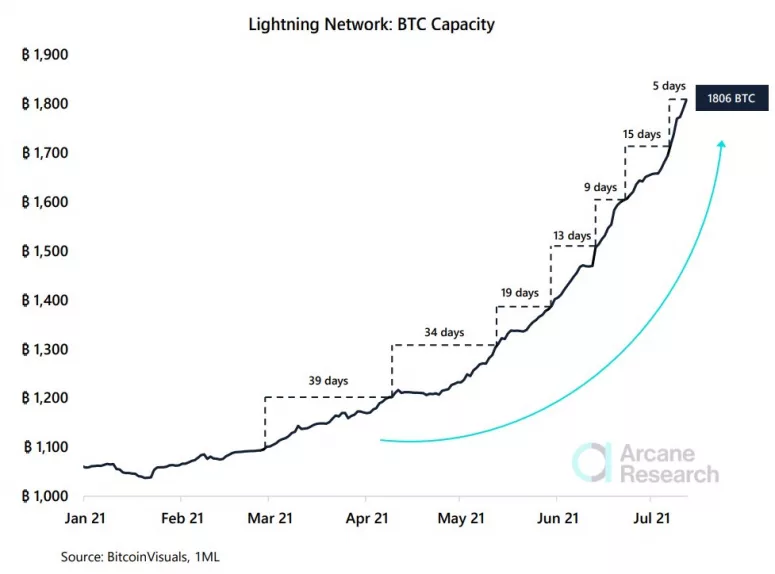The Lightning Network recorded its quickest 100 bitcoin (BTC, +2.32%) capacity growth ever at only five days. This month alone, the network capacity has increased 20% to 1,821.29 BTC locked in across more than 56,000 channels.
The Lightning Network sees its quickest 100 bitcoin growth ever.
Source: Arcane Research
As it is right now, the Bitcoin network can process up to seven transactions per second. This throughput would need to increase by magnitudes in the thousands or even millions in order to host the global economy, mostly due to the fact that any blocks written above 1 megabyte are invalid on the current Bitcoin mainnet.
Although many have proposed a change to this limitation, increasing the number of transactions in a single block would mean the blockchain size would grow too quickly for modern storage tech, leaving behind casual node operators.
Since then, many have complained about Bitcoin’s ability to scale. Comparisons to transaction processing networks like Visa and PayPal are often against the network. But Bitcoin is a base layer solution while networks like Visa and PayPal are built on the third or fourth layer of the fiat currency system, with transactions not truly being final for weeks on end.
However, with the introduction of the Lightning Network in March 2018, the Bitcoin scalability narrative has changed completely.
What is the Lightning Network?
Like Bitcoin, the Lightning Network is a network of nodes that work together peer to peer. The purpose of the Lightning Network is to facilitate secure, anti-double spending transactions on its separate “second layer” before finally settling them on the Bitcoin blockchain.
The first step in any transaction on the Lightning Network begins with a channel. A channel connects two nodes and allows them to pass information, or in this case bitcoins, to each other. Channels in the Lightning Network are built using multisignature (multisig) addresses with which both parties may interact.
These addresses allow both users to pool in (or send) as many bitcoins to the address as they want, but funds can only be extracted from this shared address given both parties agree. Think of it like a piggy bank with distinct key holes.
The Lightning Network uses multisig addresses. These addresses integrate a “timer” into the address as part of the script. That way, if one party goes offline or refuses to transact when the other party has funds in the address, the funds can be returned to their original user after a certain amount of time.
In the Lightning Network, you don’t have to set up a channel with everyone you transact with. In fact, that would be very costly as these channels must be funded to set up initially. The network utilizes onion routing from Tor, an anonymous communication network. Onion routing allows nodes to send transactions through each other while simultaneously keeping the bitcoins encrypted until they reach their final destination or “target node.”
Then, all of the transactions that pass through a channel are rewritten into a single transaction and settled on the Bitcoin network. All in all, the first variations of the Lightning Network can make up to 25 million transactions in a single second and settle it on the Bitcoin blockchain as one transaction.
Development on Lightning
The beginning of the history of the Lightning Network’s development has been slow, steady and cautious – like anything else that promises to be a major step forward for Bitcoin. As other coins and chains touted “faster, cheaper transactions,” many bitcoiners were becoming increasingly impatient for Lightning to be ready for prime time. Even now it’s not quite there, and developers caution users that it’s still in early stages of development.
But that’s not to say that the Lightning Network isn’t functional. Indeed, it’s becoming more and more useful every day.
“It's no longer just the future. Lightning is here.”
Elizabeth Stark, CEO of Lightning Labs
There are several implementations of Lightning being developed by different teams, all working toward the same goal: making Lightning more stable, secure, efficient, private and easy to use. For example, Blockstream is the force behind to the c-Lightning implementation, which focuses on extendibility, while Lightning Labs is devoted to developing IND, the most widely used implementation at this point.
Development has allowed the onboarding of more users and node operators. More and more Lightning wallets are springing up, both custodial and non-custodial, with varying degrees of user-friendly interfaces that allow for quick, secure and seamless transactions.
Oleg Mikhalsky is a partner at Fulgur Ventures, a firm which specializes in researching and investing in Lightning-focused projects. He credits some of the rapid growth of nodes to the advent of “easy-to-use infrastructure” that makes running nodes more user-friendly for the less-techy crowd.
For example, there is a plethora of tutorials and videos that will help new users set up DIY nodes. Alternatively, enthusiasts can simply buy an out-of-the-box, plug-and-play setup like a Nodl.
At least seven major crypto exchanges and trading desks, including OKEx, Okcoin, Bitfinex and River Financial have integrated Lightning into their platforms, with the Kraken exchange’s integration in the works for this year.
Okcoin also reiterated its dedication to the project by giving a developer grant to Lightning dev Antoine Riard. CEO Hong Fang said the exchange will likely put money into research and new user onboarding for the Lightning Network in the future.
Lightning wallet developers have been on the receiving end of several development grants lately, including $25,000 from The Human Rights Foundation to each of the Breez and Sphinx Lightning wallet teams.
Growing Lightning adoption
Although still in its early days, the network often reports promising interactions. In April, it reached a milestone of 10,000 nodes and had just over 45,000 payment channels holding 1,158 BTC.
Since then, network capacity has ballooned to 1,821.29 BTC locked in channels, adding a 20% increase this month alone. The number of nodes more than doubled to 22,781 while the number of channels jumped to 56,103. For context, it took nearly a year for the number of nodes to double last time from 5,000 to 10,000.
This month alone, the network capacity has increased 20% to 1,821.29 BTC locked in across more than 56,000 channels.
Source: BitcoinVisuals node, 1ML
This growth can be attributed, in part, to the recent news of bitcoin’s adoption in El Salvador as legal tender. With more Salvadorans having access to bitcoin, faster and simpler transactions needed to be implemented. As Elizabeth Stark, Lightning Labs’ CEO said: “The end user shouldn’t have to know about channels.”
Strike, a Bitcoin transaction processing company led by Jack Mallers, uses the Lightning Network for its mobile application, which is seeing rapid adoption in places like El Salvador due to its user compatibility and quick transaction times.
Mikhalsky noted that “with onchain fees going up with bitcoin appreciation cycle, it’s becoming an imperative to use Lightning as a low cost alternative to transfer smaller amounts of bitcoin.” This use case is now being put to the test in areas like Bitcoin Beach and across El Salvador.
Another factor that could be motivating some users is the ability to earn yield from contributing liquidity to the network. Lightning Lab’s liquidity marketplace, Lightning Pool, launched in 2020, allows users to lease liquidity on payment channels. This allows new channels to be opened up to users who do not have any connections to the network to begin with for much cheaper, effectively spreading out costs amongst volunteering network participants. Volunteers earn BTC rewards in return.
Mikhalsky added, “Taking into account potential network effects, we can say that this is only the beginning and we will definitely see more use cases that will further drive adoption.”
All writers’ opinions are their own and do not constitute financial advice in any way whatsoever. Nothing published by CoinDesk constitutes an investment recommendation, nor should any data or Content published by CoinDesk be relied upon for any investment activities. CoinDesk strongly recommends that you perform your own independent research and/or speak with a qualified investment professional before making any financial decisions.
Recommended Content
Editors’ Picks

SEC Crypto Task Force plans to establish digital asset regulatory sandbox
The Securities & Exchange Commission's (SEC) Crypto Task Force met with El Salvador's National Commission on Digital Assets (CNAD) representatives to discuss cross-border regulation and a proposed cross-border sandbox project.

DeFi Dev Corp buys additional 65,305 SOL amid broader institutional interest: Solana price slides below $150
Solana (SOL) price faces growing overhead pressure and slides below $150 to trade at $148 at the time of writing on Thursday. The sudden pullback follows the crypto market's edging higher on improving investor sentiment, which saw SOL climb to $154 on Wednesday.

Uniswap Price Forecast: UNI whale moves 9 million tokens to Coinbase Prime
Uniswap (UNI) price hovers around $5.92 at the time of writing on Thursday, having rallied 12.8% so far this week. According to Wu Blockchain, data shows that the address potentially related to the Uniswap team, investor, or advisor transferred 9 million UNI to the Coinbase Prime Deposit on Thursday.

Tron DAO announces $70B USDT supply: Here's how TRX price could react
TRON’s USDT circulation just surpassed $70 billion, signaling rising network utility as TRX price approaches a technically significant breakout. On Wednesday, TRON DAO confirmed that the circulating supply of Tether (USDT) on its blockchain has surpassed $70 billion.

Bitcoin Weekly Forecast: BTC holds steady, Fed warns of tariffs’ impact, as Gold hits new highs
Bitcoin price consolidates above $84,000 on Friday, a short-term support that has gained significance this week. The world's largest cryptocurrency by market capitalization continued to weather storms caused by US President Donald Trump's incessant trade war with China after pausing reciprocal tariffs for 90 days on April 9 for other countries.

The Best brokers to trade EUR/USD
SPONSORED Discover the top brokers for trading EUR/USD in 2025. Our list features brokers with competitive spreads, fast execution, and powerful platforms. Whether you're a beginner or an expert, find the right partner to navigate the dynamic Forex market.

